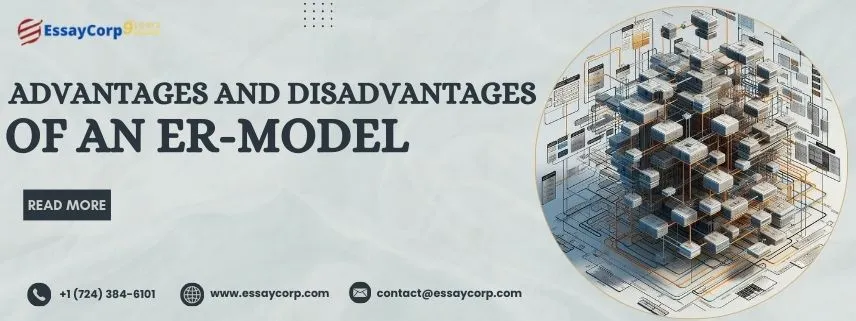Entity-Relationship Models (ER Models) are the foundational tools in the realm of database design, representing the structural framework of data within systems. They offer a visual and academic blueprint of how data interacts with and relates to each other, making them necessary for database architects and developers. However, like any tool, ER Models come with their own set of advantages and disadvantages. In this article, we'll explore the significant advantages and disadvantages of using the ER model, providing a balanced perspective for those considering their implementation.
What is an ER-Model?
Before exploring the pros and cons, it’s crucial to understand what an ER-Model is. An entity-relationship model is a graphical representation that depicts the relationships between entities within a database. Entities are objects or concepts that can have data stored about them, while relationships illustrate how these entities interact with one another. ER Models use symbols like rectangles (for entities), diamonds (for relationships), and ovals (for attributes) to represent these elements, creating a clear map of how data is structured and linked.
ER Model Components:
Entities: These are the core building blocks of an ER model and represent objects or concepts within the database.
Relationships: Relationships describe how entities interact with each other, forming the backbone of the database's structure.
Attributes: Attributes define the properties or characteristics of entities, providing additional information about them.
Notations and Symbols:
In ER modeling, specific symbols and notations are used to represent entities, relationships, and attributes within diagrams. These symbols help to visually communicate the structure and connections within the database.
Advantages of an ER-Model
1. Simplicity and Clarity
One of the most significant advantages of ER Models is their simplicity. They provide a clear and straightforward way to visualize data relationships. This simplicity makes it easier for stakeholders, including non-technical team members, to understand the structure of the database without needing in-depth technical knowledge. This clarity is particularly beneficial during the initial stages of database design, where a comprehensive understanding of data requirements is crucial for successful implementation.
2. Effective Communication
ER Models serve as an excellent communication tool between database designers, developers, and end-users. The visual nature of ER diagrams facilitates better discussion and feedback, ensuring that all parties have a shared understanding of the database structure. This shared understanding helps prevent miscommunication and ensures that the final database design meets the needs and expectations of all stakeholders, enhancing collaboration and reducing the risk of costly redesigns later in the development process.
3. Enhanced Documentation
An ER Model provides comprehensive documentation of the database structure. This documentation is invaluable for future maintenance and updates, as it offers a detailed map of how data is organized and interconnected. Having detailed documentation simplifies onboarding for new team members and ensures continuity, as the ER Model can serve as a reference guide for understanding the database’s architecture and its underlying logic.
4. Supports Database Design
ER Models are crucial during the database design phase. They help in organizing data requirements systematically and identifying the relationships among different data entities. This structured approach ensures that the database is well-designed from the outset, reducing the likelihood of issues down the line. By visually mapping out data interactions, ER Models assist in identifying potential problems early, such as redundant data or unclear relationships, thus facilitating a more efficient and effective design process.
5. Facilitates Data Integrity
By clearly defining relationships and constraints between data entities, ER Models help maintain data integrity. For instance, primary and foreign keys can be visually mapped, ensuring that referential integrity is upheld within the database. This particular mapping of data relationships ensures that data remains accurate and consistent, preventing irregularities such as orphan records or duplicate entries, which can compromise the quality and reliability of the database.
6. Adaptability
ER Models are adaptable and can be easily modified to reflect changes in the system’s requirements. This flexibility is essential in dynamic business environments where data requirements may evolve over time. Being able to update the ER Model to incorporate new data entities, relationships, or attributes without disrupting the existing structure ensures that the database can grow and adapt alongside the organization’s needs.
7. Promotes Efficient Querying
A well-structured ER Model can lead to efficient database querying. By understanding the relationships and dependencies between entities, developers can write optimized queries that enhance performance and speed up data retrieval. This efficiency is particularly important for applications that require quick and reliable access to large volumes of data, as optimized queries can significantly reduce load times and improve the overall user experience.
Need Urgent Assignment Help?
Disadvantages of an ER-Model
1. Complexity in Large Systems
While ER Models are straightforward for smaller systems, they can become exceedingly complex as the system grows. Large databases with numerous entities and relationships can result in convoluted diagrams that are difficult to read and manage. This complexity can obscure the overall understanding of the database structure, making it challenging to maintain and troubleshoot, especially as more entities and relationships are added over time.
2. Time-Consuming Development
Creating an ER Model can be time-consuming, particularly for large and complex databases. The process requires meticulous planning and detailed analysis to ensure accuracy, which can delay the development timeline. The initial investment in time and resources can be substantial, and if not managed properly, it can lead to project delays and increased costs, especially when dealing with intricate data requirements.
3. Limited to Logical Design
ER Models primarily focus on the logical design of a database and do not directly address physical database design. Additional steps are necessary to translate the ER Model into a physical schema, which can introduce potential discrepancies if not handled carefully. The transition from logical to physical design requires careful planning and attention to detail to ensure that the final implementation accurately reflects the intended design and performance requirements.
4. Hardness in Design
Once an ER Model is established, making significant changes can be challenging. Any alteration in the database requirements might necessitate a substantial redesign of the ER Model, which can be both time-consuming and resource-intensive. This rigidity can be a drawback in fast-paced environments where requirements frequently change, as it can limit the ability to quickly adapt and implement new features or changes.
5. Potential for Oversimplification
In striving for simplicity, ER Models can sometimes oversimplify real-world scenarios. Complex relationships and constraints might not be fully captured, leading to a less accurate representation of the actual data requirements. This oversimplification can result in a database design that does not fully meet the needs of the application, requiring additional adjustments and refinements during development.
6. Not Always Intuitive for Newcomers
For individuals new to database design, ER Models might not be immediately intuitive. Understanding the notation and conventions used in ER diagrams requires some level of training and experience. Without proper guidance, newcomers may struggle to interpret the diagrams correctly, which can lead to misunderstandings and errors in the database design process.
7. Scalability Issues
Scalability can be a concern with ER Models. As the amount of data and the number of entities increase, maintaining and updating the ER Model can become unwieldy, potentially hindering the database’s performance and manageability. Ensuring that the ER Model remains scalable requires careful planning and ongoing evaluation to manage the complexity and ensure that the database continues to perform efficiently as it grows.
FAQs
1. What is an ER-Model?
A1. A visual representation of a database's entities and their relationships, used for designing database structures.
2. How does an ER-Model help in database normalization?
A2. Identifies entities and relationships, forming a foundation for organizing data efficiently and reducing redundancy.
3. Can an ER-Model be used for non-relational databases?
A3. Yes, concepts can be adapted, but representation and tools might differ.
4. How do ER-Models support database documentation?
A4. Provide visual schema documentation, aiding understanding and communication among stakeholders.
5. Common tools for creating ER-Models?
A5. Microsoft Visio, Lucidchart, ER/Studio, Oracle SQL Developer Data Modeler, MySQL Workbench.
6. What is the difference between ER-Models and EER-Models?
A6. EER Models extend ER Models with subclasses, superclasses, and categorization for more complex designs.



.png) Contact Us, Today!
Contact Us, Today! 